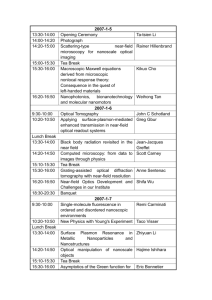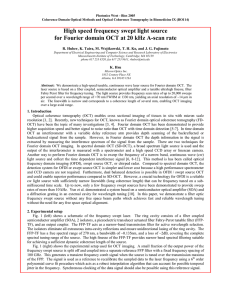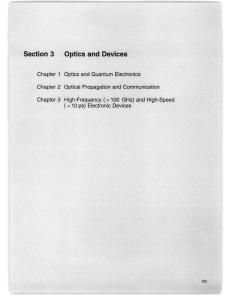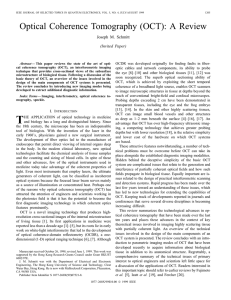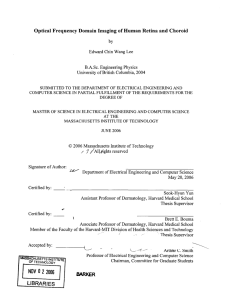Abstract - UROP - University of California, Irvine
advertisement
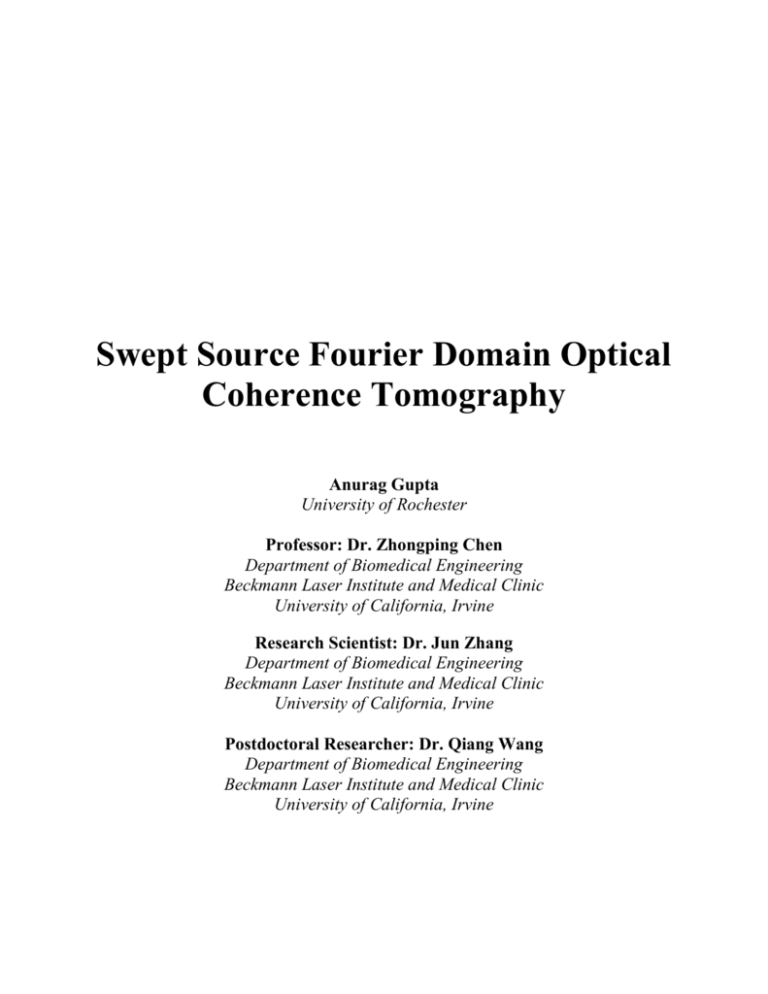
Swept Source Fourier Domain Optical Coherence Tomography Anurag Gupta University of Rochester Professor: Dr. Zhongping Chen Department of Biomedical Engineering Beckmann Laser Institute and Medical Clinic University of California, Irvine Research Scientist: Dr. Jun Zhang Department of Biomedical Engineering Beckmann Laser Institute and Medical Clinic University of California, Irvine Postdoctoral Researcher: Dr. Qiang Wang Department of Biomedical Engineering Beckmann Laser Institute and Medical Clinic University of California, Irvine Abstract In Optical Coherence Tomography (OCT), broadband light source is used to create highresolution cross-sectional images of biological samples, non-invasively. The advantage of the compact fiber based endoscopic system is that it can create images with approximately 10 µm resolution. Currently, this is accomplished utilizing the time-domain technique. However, the acquisition of images is slow and the ability to control the optical dispersion is difficult. To correct these problems, we utilize the Fourier domain technique because it allows us to create cross-sectional images of live tissue, blood vessels and the eye at up to 25 frames per second (theoretically), while allowing us the ability to control optical dispersion by the combination of the fast Fourier transforms and subtracting out the appropriate non-linear phase. Also, we are using a bandpass filter to select for the positive Fourier transform followed by a phase modulator (LiNbO3 crystal) driven by an Arbitrary Waveform Generator to increase the signal to noise ratio. The ideal outcome is to detect cancer and other diseases at a much earlier stage, while decreasing the amount of time needed to insert an endoscope into the human body for the acquisition of medical images. Key Terms Fourier-Domain, Histology, Optical Biopsy, Optical Coherence Tomography, and Time-Domain Introduction In medicine today, doctors are in the need for a medical imaging modality that is portable, inexpensive and can produce images of medical diseases and other problems non-invasively at resolutions of 10 micrometers or smaller. To help solve this problem, Dr. James Fujimoto invented the Optical Coherence Tomography (OCT) in 1991. He stated in a seminar at Duke University that “Optical coherence tomography (OCT) is an emerging imaging modality which can generate high resolution, cross-sectional images of microstructure in biological systems (“Spring Seminar Series”, 2005).” The science behind OCT is analogous to that of Ultrasound B. In OCT a broadband light source is used to create cross-sectional images and in Ultrasound sound waves are used to create images (“Spring Seminar Series”, 2005). The acquisition of medical images with OCT is much quicker than that of Ultrasound B is because the speed of light, 3 x 108 m/s, is greater than the speed of sound, 1450 m/s. Based on the source used for imaging, the lateral, x-axis, and axial/penetration depth, y-axis, resolutions are quite different and displayed below in the graph: -2- Standard Resolution (log) 1 mm clinical High frequency 100 µm Ultrasound 10 µm Confocal microscopy OCT 1 µm Penetration depth (log) 1 mm 1 cm 10 cm Figure 1: The graph, from http://www.risoe.dk/ofd/oct/OCT_apps.htm, shows the lateral resolutions and penetration depths that can be achieved by differing medical imaging modalities. From this graph, we can see that the lateral resolution obtained by OCT is about 15 micrometer – 1 micrometer and the penetrationn depth is about 2 – 3 milimeter. This provides a significant improvement over Ultrasound and High Frequency Ultrasound and demonstrates that OCT maybe a viable option for imaging cancer and other medical problems such as burns with more precision and reliability. Because OCT creates cross-sectional images of live tissues, it has the potential to be used for “optical” biopsy, an in-vivo medical imaging test for determing cancer (Fujimoto, 2002). The results of the “optical” biopsy are being verified by biopsy, an ex-vivo laboratory test for determing cancer, to analyze its accuracy, precision, and reliability. The current OCT designs are designed to be compact, portable, relatively inexpensive, and robust. The earlier versions of the OCT were created utilizing the time-domain technique. Writing the C++ based program for this system is easier because the optical power is known at any given time point. However, the imaging speed is slow and poses problems when imaging areas like that of the throat because one cannot breathe for the time it takes to acheive the desired images. Therefore, researchers are switching over to the Fourier-domain technique because it’s quicker to reconstruct images from optical frequency values than it is from optical power values. The Fourier domain technique determines the optical frequency values by computing the fast fourier transorm in C++. Within Fourier Domain OCT (FDOCT), the system can become more robust by removing the need for a line-scan camera by using a rapidly swept laser source (Zhang et al, 2006). For these reasons, we have choosen to design a compact and robust fiber-based 1.3 µm Swept Source Fourier Domain Optical Coherence Tomography. -3- Material and Methods Electro-Optical Phase Modulator Implementation A spectrum analyzer is an “instrument used to display the frequency domain of a waveform plotting amplitude against frequency” and this graph gives one a good understanding of the noise present at any given point (http://www.sciencelobby.com/dictionary/s.html, 2004). Based on the noise present in a system, one can calculate the signal to noise ratio (SNR). 2 si gnal ps kT SNRFDOCT h noise Figure 2: Signal to Noise Ratio ps (SNR) kT ' for a Fourier-Domain Optical Coherence Tomography (FDOCT) TDOCT device. This equation was presented by Fei Wang to the EE131 class at Caltech (Wang, h 2006) SNR T' T N This ratio will show at which frequency the signal to noise ratio is maximized. For our system we determined that from 5 MHz to 27 MHz our system will have a higher SNR by analyzing the graph outputted by the spectrum analyzer. To shift our frequency to this region we used an Electro-Optical phase modulator. We chose to use a LiNbO3 JDSU phase modulator that was driven by a Tektronics Arbitrary Waveform Generator 2021. Software Design When designing software and hardware for the acquisition of medical images, it is important to take into consideration the speed and the ease at which the programming language can run the program. In addition, the software created should be easy for technicians to use. For these reasons, we have decided to use Microsoft Visual C++. Microsoft Visual C++ has the ability to acquire data from any number of devices and can be programmed to control precisely the movements of different instruments, especially the instrument used to scan our biological samples. To make sure that our software algorithms can reconstruct our frequency spectrum values into discernable images, we have to make sure that the optical path length of the sample arm is the same as the optical path length in the reference arm. Optical path length is calculated by multiplying the physical length of space of fiber optic cables with the impedance of the laser light in the fiber optic cable and adding this value to the multiplication of free space found from the end of the fiber optic cable length to the end of the reference or sample arm end with the impedance value of air. Because this project is about making a compact fiber based OCT device, it is important to minimize the length of the fiber optic cables without straining them. In our OCT setup, we utilize a Thorlabs PDB110C photodetector to convert the optical signal to an electrical (voltage) signal. The voltage signal is inputted into the computer for analysis and creation of image via a bnc cable connected to the National Instruments (NI) BNC2110, BNC Shielded Connector Box, which is connected to an internal NI 5122 data acquisition card (DAQ) and digitizer. The NI 5122 digitizer feature converts the incoming analog signal to a -4- digital signal at the rate of 100 Mega Samples per second (MS/s), which NI states to be real-time (http://www.ni.com/pdf/products/us/pxi5122.pdf, 2006). Figure 3: An NI BNC-2110, BNC Shielded Connector Box, http://pds1.exblog.jp/pds/1/200502/27/91/c0067591_1936186.jpg. Figure 4: An NI 5122 Data Acquisition and Digitizer card, http://sine.ni.com/images/products/us/pxi_5122_030725_l.jpg. To capture upon this real-time data acquisition and digitizing, we created special algorithms using C++ to reconstruct our images from frequency spectrum values. When the software was first working, it ran at 9/10 frames per second. After some optimization, such as making sure that within nested for loops when variables were temporarily being converted to integers that it was not also being rounded down to the nearest integer using the keyword float. This is because when a non-integer value is being temporarily converted to an integer, it is automatically rounded down to the lower integer, for example a 3.5454 is rounded down to a 3, and then if floored the computer becomes confused on how to round a rounded number. Another way that we optimized the software was to make multiple threads, and take advantage of the fact -5- that we were running our software on the latest Dell Workstation with two 3.2+ GHz Pentium Xeon processors with a total of four execution cores. Therefore, we designed our software to have four threads, for example a thread for data acquisition and one for image processing algorithms, and have each one run on an independent execution core. At this point, we are at 15/16 frames per second and we are still researching new ways to improve our software to reach our theoretical threshold of 25 frames per second. Creation of a 3D Scanner for the Acquisition of Medical Images The sample arm used to test the system is not the same as the sample arm that is going to be used to acquire images. We created a mirror based sample arm with the appropriate optical path length to test our software algorithms. In the end, we would like a scanner that sits upon a stage that can move in the x and y directions at about -10 to 10 degrees. The scanner was designed by Dr. Ahn of the Beckman Laser Institute. With his guidance and the help of Dr. Qiang Wang, the scanner was assembled with a colometer, two galvometers and control drivers (one for the x direction and the other for the y direction), a mirror specifically designed for 1300 nm wavelengths, lens for focusing the laser beam, and a power supply. To align each galvometer, the galvometer has to be connected to a control driver, the control driver needs to be connected to a power supply, and the control driver needs to be connected to a function generator or a computer that can apply voltages on the galvometer. The galvometer control drivers are set to -23 – +23 volts and 300 milliamps of current for safe, quick and fluid operation. The function generator or computer is needed because we want to set the voltage to 0 V and the frequency to 1 Hz to make sure that our mirror is at the zero position or not moving in free space. Once these parameters are set, we can use an aiming beam laser to align each galvometer, independently, so that the laser beam is exiting the proper hole at the center point, the beam strength and location is the same at close distances as well as far distances, several feet away, and that the laser beam is fully shown, not eclipsed at any point in the circle. Results Software Speed 15/16 Frames per Second -6-






